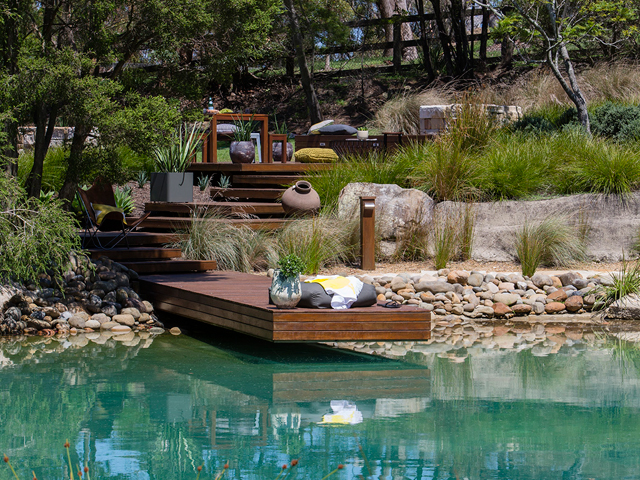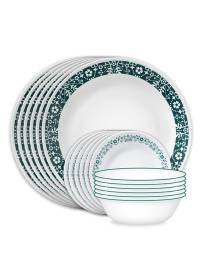Fire-Proof Your Outdoor Spaces

Top Tips For Fire-Proofing Your Outdoor Spaces
With a brutal bushfire season predicted for the weeks and months ahead, Landart Landscapes' Matt Leacy shares some tips for mitigating fire risks in your outdoor spaces.
"I love the Australian bush, and live near bushland myself, so I would never want to seem alarmist in my approach to fire-prepping. However, the reality is that we're already experiencing devasting fire conditions in many parts of Australia and signs are pointing to a long, dry summer – so we've got to be as proactive as possible when it comes to mitigating fire risks to our homes and outdoor spaces," says Matt, who is also resident garden guru on Channel Ten's The Living Room.
"While there's no way to entirely fire-proof your property, property owners shouldn't underestimate how much a good garden clean-up, prune and some clever plant choices can potentially make in reducing bushfire risks to your home," Matt adds.
Below, Matt shares his top tips for fire-proofing your outdoor spaces.
1. Tidy up and trim back
"As much as it may seem an obvious and tedious task, one of the best things you can do is to thoroughly prune and tidy up around your gardens and property," says Matt.
"Clean gutters, especially if your house is surrounded by large trees," adds Matt. "Also, ensure that all old dry leaves from autumn and winter are cleared out and away from your property – and that dead branches are cut away, and trees and other plants are trimmed right back away from your house."
"You might also consider installing some fire irrigation on the roof or some extra hose points. If a fire borders your property, it could make a critical difference to be able to wet your house down and put out spot fires from embers from multiple angles," says Matt.
2. Know what is in your garden
"It's useful to have at least some knowledge of how flammable the plants and trees on your property are – and if you're unsure and surrounded by lots of gardens and bushland, it might be worth engaging a professional to help inform you," says Matt.
"Trees that are known ignite quickly (and some will even explode) include tea tree, Cyprus, pines, eucalypts and various other natives," says Matt.
"Obviously, if you have a beautiful, well-established eucalyptus tree – which is also an important wildlife habitat, you aren't likely going to want to remove it entirely. But if you can prune it back and maintain it – especially the branches that are dying off – as well as control what's around it, you'll help to reduce associated fire risks."
"Just be sure to check with your local authority as to how much of the tree you can remove each year," adds Matt.
3. Landscaping choices
"When introducing new varieties into your outdoor spaces, choose plants that are fire retardant – that is, plants that don't ignite and therefore make areas less flammable," says Matt.
"These will help protect your property from falling embers and are usually plants that have a high moisture content in their leaves, as well as big thick leaves rather than fine hard leaves."
"Some of these plans include, saltbush, lavender, hydrangea, white cedar, succulents, grey or silver mulga, wattles, lilly pilly, kangaroo paw, palms, Moreton bay figs, Scaevola – fan flower, Cyathea, Dianella, Hymenopsermum – Native frangipani, Myoporum, Senecio, Syzygium viola and various species of flax and pigface.
"Keep in mind that if some of these plants dry out, they may then burn" cautions Matt.
"Vegetables (especially if you have a patch bordered by a pathway or pebbles) are also a great option," says Matt.
"It is also better to choose plants with smooth bark, rather than plants that have rough bark," adds Matt. "I recommend checking with your nursery to ensure the plants I'm suggesting are suitable to your specific area."
"Also, do your best when designing your garden to plant fire resistant trees and plants in a shield format, particularly if your property is bordered on any side by bushland" says Matt.
"Lower shrubs and groundcovers are a better choice than tall big trees or hedges."
"If you're mulching, consider using stones, gravel or pebbles rather than woodchips that will act as a fire fuel," says Matt.
"From a design perspective, if you are starting fresh with a new garden, or can adapt what you already have, I'd suggest planting trees at least 10 metres from you house," says Matt. "Also, include pebbled, paved, tiled or concrete pathways to help create fire breaks."
"If you can (and this is more so if your property backs onto or is surrounded by a National Park), look to create a design that integrates a pool, tennis courts or big stretches of lawn, between the bushland and the house," says Matt.
"Also, try to avoid clumping too many trees together; a tight canopy can carry fire."
"And, above all, try to avoid having trees that grow over or onto your house," emphasises Matt.
4. Lawns and water provision
"Lawns can also act as a physical barrier, if you've been able to keep them green during water restrictions and very dry conditions," says Matt.
"It's also a smart idea to pre-plan for upcoming rainfall and install water tanks now," suggests Matt "When we do eventually get rain, these tanks can be used to maintain a green garden, which can help to ward off the severity of bushfires later down the track."
"You might also look into the feasibility of sinking a bore for watering," says Matt. "You will, however, need to obtain the correct approval/licencing before doing so – and it can be a little costly, though worthwhile process."
"Drip watering systems are also a great, simple and cost-effective way to transport water into your garden in an eco-friendly manner," adds Matt.
5. Help local fauna find refuge
"If you're in the sad situation of being hit by fires (and hopefully it's just your garden you need to re-build), or you live in an area with bushland that's been ravaged by fires, look at how you can help support the animals in the area," says Matt.
"In most cases, this will mean a back-to-basics approach – leaving out buckets of water or incorporating water features with fresh water or bird baths into your garden design," he says.
"If you know what animals are in your region, you might look at establishing plants and garden features that wildlife could seek refuge in and use as a food source," Matt adds. "You could also purchase seed to feed birds and other animals in extreme situations."
"Note that if you're encouraging wildlife into your garden, you should be more vigilant with cats and other domestic pets that may hunt displaced fauna seeking refuge in your outdoor spaces," Matt cautions.
Matt Leacy is a co-founder of the award-winning Landart Landscapes. He is also Channel 10 The Living Room's resident landscape designer.
Matt has more than 20 years' experience in design, construction and maintenance services across landscaping and pool installation for both residential and commercial properties.
Matt is a qualified structural landscaper, designer, horticulturalist and current board member – and former president – of the LNA Master Landscapers Association, which is the equivalent of the Master Builders Association for the landscaping industry.
Matt has also worked with City of Sydney in previous years, spearheading their Living Colour installations to bring life and colour to inner-city streets.
Outside of work, Matt enjoys spending time with his wife Marie and their three young children. He has a passion for the outdoors, active living and holistic health. He is also an avid advocate for disability support and awareness – interests that stem, in part, from his own personal family experiences with disability, including dementia and neurological disorders.
A selection of Matt's work can be found at www.landart.com.au
"I love the Australian bush, and live near bushland myself, so I would never want to seem alarmist in my approach to fire-prepping. However, the reality is that we're already experiencing devasting fire conditions in many parts of Australia and signs are pointing to a long, dry summer – so we've got to be as proactive as possible when it comes to mitigating fire risks to our homes and outdoor spaces," says Matt, who is also resident garden guru on Channel Ten's The Living Room.
"While there's no way to entirely fire-proof your property, property owners shouldn't underestimate how much a good garden clean-up, prune and some clever plant choices can potentially make in reducing bushfire risks to your home," Matt adds.
Below, Matt shares his top tips for fire-proofing your outdoor spaces.
1. Tidy up and trim back
"As much as it may seem an obvious and tedious task, one of the best things you can do is to thoroughly prune and tidy up around your gardens and property," says Matt.
"Clean gutters, especially if your house is surrounded by large trees," adds Matt. "Also, ensure that all old dry leaves from autumn and winter are cleared out and away from your property – and that dead branches are cut away, and trees and other plants are trimmed right back away from your house."
"You might also consider installing some fire irrigation on the roof or some extra hose points. If a fire borders your property, it could make a critical difference to be able to wet your house down and put out spot fires from embers from multiple angles," says Matt.
2. Know what is in your garden
"It's useful to have at least some knowledge of how flammable the plants and trees on your property are – and if you're unsure and surrounded by lots of gardens and bushland, it might be worth engaging a professional to help inform you," says Matt.
"Trees that are known ignite quickly (and some will even explode) include tea tree, Cyprus, pines, eucalypts and various other natives," says Matt.
"Obviously, if you have a beautiful, well-established eucalyptus tree – which is also an important wildlife habitat, you aren't likely going to want to remove it entirely. But if you can prune it back and maintain it – especially the branches that are dying off – as well as control what's around it, you'll help to reduce associated fire risks."
"Just be sure to check with your local authority as to how much of the tree you can remove each year," adds Matt.
3. Landscaping choices
"When introducing new varieties into your outdoor spaces, choose plants that are fire retardant – that is, plants that don't ignite and therefore make areas less flammable," says Matt.
"These will help protect your property from falling embers and are usually plants that have a high moisture content in their leaves, as well as big thick leaves rather than fine hard leaves."
"Some of these plans include, saltbush, lavender, hydrangea, white cedar, succulents, grey or silver mulga, wattles, lilly pilly, kangaroo paw, palms, Moreton bay figs, Scaevola – fan flower, Cyathea, Dianella, Hymenopsermum – Native frangipani, Myoporum, Senecio, Syzygium viola and various species of flax and pigface.
"Keep in mind that if some of these plants dry out, they may then burn" cautions Matt.
"Vegetables (especially if you have a patch bordered by a pathway or pebbles) are also a great option," says Matt.
"It is also better to choose plants with smooth bark, rather than plants that have rough bark," adds Matt. "I recommend checking with your nursery to ensure the plants I'm suggesting are suitable to your specific area."
"Also, do your best when designing your garden to plant fire resistant trees and plants in a shield format, particularly if your property is bordered on any side by bushland" says Matt.
"Lower shrubs and groundcovers are a better choice than tall big trees or hedges."
"If you're mulching, consider using stones, gravel or pebbles rather than woodchips that will act as a fire fuel," says Matt.
"From a design perspective, if you are starting fresh with a new garden, or can adapt what you already have, I'd suggest planting trees at least 10 metres from you house," says Matt. "Also, include pebbled, paved, tiled or concrete pathways to help create fire breaks."
"If you can (and this is more so if your property backs onto or is surrounded by a National Park), look to create a design that integrates a pool, tennis courts or big stretches of lawn, between the bushland and the house," says Matt.
"Also, try to avoid clumping too many trees together; a tight canopy can carry fire."
"And, above all, try to avoid having trees that grow over or onto your house," emphasises Matt.
4. Lawns and water provision
"Lawns can also act as a physical barrier, if you've been able to keep them green during water restrictions and very dry conditions," says Matt.
"It's also a smart idea to pre-plan for upcoming rainfall and install water tanks now," suggests Matt "When we do eventually get rain, these tanks can be used to maintain a green garden, which can help to ward off the severity of bushfires later down the track."
"You might also look into the feasibility of sinking a bore for watering," says Matt. "You will, however, need to obtain the correct approval/licencing before doing so – and it can be a little costly, though worthwhile process."
"Drip watering systems are also a great, simple and cost-effective way to transport water into your garden in an eco-friendly manner," adds Matt.
5. Help local fauna find refuge
"If you're in the sad situation of being hit by fires (and hopefully it's just your garden you need to re-build), or you live in an area with bushland that's been ravaged by fires, look at how you can help support the animals in the area," says Matt.
"In most cases, this will mean a back-to-basics approach – leaving out buckets of water or incorporating water features with fresh water or bird baths into your garden design," he says.
"If you know what animals are in your region, you might look at establishing plants and garden features that wildlife could seek refuge in and use as a food source," Matt adds. "You could also purchase seed to feed birds and other animals in extreme situations."
"Note that if you're encouraging wildlife into your garden, you should be more vigilant with cats and other domestic pets that may hunt displaced fauna seeking refuge in your outdoor spaces," Matt cautions.
Matt Leacy is a co-founder of the award-winning Landart Landscapes. He is also Channel 10 The Living Room's resident landscape designer.
Matt has more than 20 years' experience in design, construction and maintenance services across landscaping and pool installation for both residential and commercial properties.
Matt is a qualified structural landscaper, designer, horticulturalist and current board member – and former president – of the LNA Master Landscapers Association, which is the equivalent of the Master Builders Association for the landscaping industry.
Matt has also worked with City of Sydney in previous years, spearheading their Living Colour installations to bring life and colour to inner-city streets.
Outside of work, Matt enjoys spending time with his wife Marie and their three young children. He has a passion for the outdoors, active living and holistic health. He is also an avid advocate for disability support and awareness – interests that stem, in part, from his own personal family experiences with disability, including dementia and neurological disorders.
A selection of Matt's work can be found at www.landart.com.au
MORE



